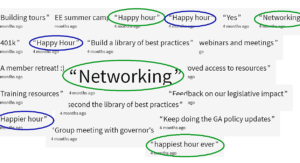
Last Spring, we asked VAEEC members what additional benefits they would like included in their membership. The results were clear. Our members are looking for more networking opportunities. That’s why we paired up with RVA Green Drinks to host a Richmond-area happy hour.
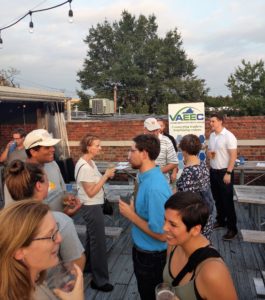 The event proved successful as approximately 30 green business and energy efficiency professionals showed up to meet, mingle, learn about energy efficiency, and soak up the sun on Postbellum‘s rooftop deck.
The event proved successful as approximately 30 green business and energy efficiency professionals showed up to meet, mingle, learn about energy efficiency, and soak up the sun on Postbellum‘s rooftop deck.
Thank you to everyone who came out. We enjoyed catching up with our members and meeting new people interested in Virginia’s energy efficiency sector. We might be a little biased, but we think it was one of the “happiest hours” yet!
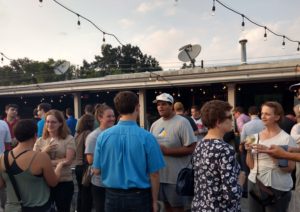 For our members outside of the Richmond-area, we want to include you too. Let us know if you would like to partner to co-host a happy hour event in your area by emailing info@vaeec.org.
For our members outside of the Richmond-area, we want to include you too. Let us know if you would like to partner to co-host a happy hour event in your area by emailing info@vaeec.org.
 There has been an increase in C-PACE activity and progress across the Commonwealth in the past few months, including several localities taking steps to enact their own program. Learn about these updates and resources by reading below, or by listening to a recording of our September webinar, C-PACE in Virginia: Resources Available to Localities.
There has been an increase in C-PACE activity and progress across the Commonwealth in the past few months, including several localities taking steps to enact their own program. Learn about these updates and resources by reading below, or by listening to a recording of our September webinar, C-PACE in Virginia: Resources Available to Localities.
Localities Moving Forward
Arlington County: The pipeline of projects is growing, and in a milestone for the program one was recently reviewed with capital providers to determine funding interest.
City of Fredericksburg: Staff is currently drafting a C-PACE ordinance, and a project is already in line to utilize C-PACE once a program is launched.
Fairfax County: In June, the Fairfax County Board of Supervisors Environmental Committee directed staff to write an ordinance. Staff will develop and submit a draft C-PACE ordinance to be considered by the Environmental Committee during their February 2019 meeting.
Loudoun County: Back in January of this year, the Loudoun County Board of Supervisors voted to direct staff to develop a C-PACE program structure, evaluate options for program administration, and draft an ordinance. In July, the Board reconvened and staff recommended the development of a C-PACE ordinance that would utilize a third-party program administrator for services such as billing and collection of loan payments and allow the County to enforce special assessment liens in the case of defaults.
Other localities looking to move forward with developing a C-PACE program include the cities of Alexandria, Charlottesville, Norfolk, and Roanoke, and the counties of Albemarle, Spotsylvania, and Stafford.
Resources Available to Virginia Localities
Several resources have been recently released to assist localities with the development of C-PACE programs, including case studies, model ordinances, program guidelines, and an RFP template.
Model Ordinances:
- Arlington County has their Ordinance posted to the Arlington C-PACE website for anyone to view.
- Earlier this year, the VAEEC released a Virginia Model Ordinance for localities to use. This document was commissioned following input and review from a wide variety of C-PACE experts and incorporates key factors we consider to be crucial to implementing an effective C-PACE program.
- The Virginia PACE Authority, or VPA, used the Virginia Model Ordinance to create an updated and abbreviate Ordinance that localities can use.
Mid-Atlantic PACE Alliance (MAPA) Resources and Regional Toolkit: MAPA has a variety of resources available on their website. This includes fact-sheets, such as What is C-PACE and Frequently Asked Questions. Additionally, there are several case studies highlighting projects in Washington D.C. and Maryland.
As part of its mission to accelerate the development and utilization of C-PACE in the Mid-Atlantic region, MAPA has released a Regional Toolkit. The toolkit provides best practices specific to this region and guidance and resources that streamline efforts to develop and launch a C-PACE program.
RFPs for Program Administration:
- A template has been created to help localities craft their Request for Proposals (RFP) for Program Administrator services.
- Along with several resources included on their website, Arlington County has the option for Virginia localities to ride their contract with their program administrator, SRS. This step eliminates the need for a locality to go through their own RFP process for a Program Administrator.
To learn more about C-PACE, be sure to check out vaeec.org/pace or contact Jessica Greene at jessica@vaeec.org.
 When looking to significantly reduce energy costs of a state facility, a state agency can enter into an energy performance-based contract with an energy performance contractor. This Energy Performance Contract, or EPC, is an agreement between a contractor or energy services company (ESCO) and a customer to meet a guaranteed level of energy savings as a condition of payment.
When looking to significantly reduce energy costs of a state facility, a state agency can enter into an energy performance-based contract with an energy performance contractor. This Energy Performance Contract, or EPC, is an agreement between a contractor or energy services company (ESCO) and a customer to meet a guaranteed level of energy savings as a condition of payment.
Energy Performance Contracting is generally equipment replacement that allows energy savings and installation of building control systems to control energy consumption, which is implemented by the Virginia Uniform Statewide Building Code. ESCOs provide all the labor, materials, equipment, and subcontractor management while often requiring little supervision. However, companies like DMME can serve as a trusted third party to state agencies and local governments who are considering entering into an EPC.
As an added incentive, EPCs offer customers guaranteed savings. If the ESCO does not meet the guaranteed savings, they must write a check for the difference and make needed changes at their cost. Additionally, Measurement and Verification data entered by an ESCO into DOE eProjectBuilder software are made available to end users.
Thomas Nicholas, a Facilities Engineer with the City of Virginia Beach Department of Public Works and VAEEC Board member, sees the opportunities that EPCs can offer a local government:
In the fall of 2018, using the Commonwealth of Virginia’s Energy Performance Contract, the City of Virginia Beach will be seeking solicitations from experienced Energy Service Companies (ESCOs) to complete energy retrofit work. Using the City’s capital improvement funding, we are seeking a whole building approach with an emphasis on LED lighting for approximately five City facilities. Our goal is to maximize energy savings, while at the same time meet the building occupants’ requirements.
This process of receiving an Energy Performance Contract has been relatively unchanged since 2001. However, now instead of only selecting four items from the list of ESCOs, state agency’s can invite all 15 pre-approved ESCOs to the “Back of the Envelope” (BOE). This change was created with the intent to start more competition and give the agencies and public bodies more choices.
Tim Bernadowski, a VAEEC member with Siemens, has only positive things to say about the revised EPC guidelines:
The newly revised Virginia ESCO pre-qualification and energy performance contract instructions provide a framework for Commonwealth agencies as well as other public entities, to help them simplify and speed the procurement of energy performance contract services and, as a result, the implementation of energy efficiency improvements. This is important, since energy performance contracting can appear to be a complicated and imposing process, even though it is one of the best ways to implement efficiency improvements both technically and financially.
The VAEEC supports the use of EPCs as a way for state-owned buildings and public institutions of higher education to replace aging equipment and become more energy efficient. Since 2001, state and local governments and institutions of public higher education have invested nearly $900M in Energy Performance Contracting, enabling them to save money that can be better utilized elsewhere. The VAEEC looks forward to seeing an increase in EPCs across the Commonwealth as more public agencies and institutions decide to opt-in.
Click here for a current list of Energy Service Companies and here for DMME’s Performance Contracting Support page. The new Request for Proposals for the Back of the Envelope can be viewed here.
Additionally, check out our Census report to see the VAEEC’s recommendation on EPC’s!
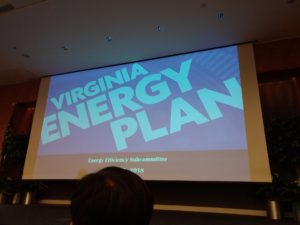 By October 1st, the State Energy Office of the Department of Mines, Minerals and Energy (DMME) must prepare an Energy Plan that covers a 10 year period and submit that plan to the Governor, the SCC Commissioners and the General Assembly. This Energy Plan is required to propose actions that are consistent with the Commonwealth’s Energy Objectives (VA. Code 67-201) including projections of energy consumption, analysis of efficient use of energy resources and conservation initiatives, analysis of whether there is a disproportionate adverse impact on economically disadvantaged or minority communities, and recommendations for legislative, regulatory, and other public and private actions.
By October 1st, the State Energy Office of the Department of Mines, Minerals and Energy (DMME) must prepare an Energy Plan that covers a 10 year period and submit that plan to the Governor, the SCC Commissioners and the General Assembly. This Energy Plan is required to propose actions that are consistent with the Commonwealth’s Energy Objectives (VA. Code 67-201) including projections of energy consumption, analysis of efficient use of energy resources and conservation initiatives, analysis of whether there is a disproportionate adverse impact on economically disadvantaged or minority communities, and recommendations for legislative, regulatory, and other public and private actions.
This year’s plan, however, will have a slightly different focus. The DMME is pushing for a greater emphasis on outcomes and how this goal can be achieved through policy. In order for this plan to be the most effective and include the most input, DMME will rely on community involvement. Specifically, they want the public to help answer the following questions:
- What legislative changes are needed?
- What regulatory changes are needed?
- Is there administration level action needed?
- Is there private activity needed?
Slides from all meetings will be posted on this website and are open for public viewing. The public has until August 24th to submit comments online to the website.
In addition to the written comments, there will also be four listening session that the public can attend:
- July 23 from 1-4 PM House Room 1 of the Capitol in Richmond
- Solar Energy Development and Energy Storage Authority Meeting and Listening Session
- July 25 from 12-2 PM in Newport News
- Offshore Wind Energy Stakeholder Meeting and Listening Session
- July 30 from 5-7 PM in Roanoke
The Virginia Energy Plan will have five tracks and each will have their own focus areas:
- Solar and Wind Resources
- Energy Efficiency
- Electric Vehicles and Advanced Transportation
- Storage
- Offshore Wind
The four focus areas for energy efficiency are:
- Achieving Virginia’s 10% energy conservation target
- Lead by example strategies
- Financing
- Program design for DMME-funded programs.
The first kickoff meeting of three energy efficiency events was held on June 25th, which included a presentation by DMME on the final recommendations from the Governor’s Executive Committee on Energy efficiency (GEC) and the next steps. There was also an open discussion with the audience on additional topics for inclusion in the energy plan.
Below you will find the list of the completed tasks related to EE since the previous energy plan update:
- established the GEC
- enacted legislation facilitating Commercial Property Assessed Clean Energy (C-PACE)
- launched the VirginiaSaves program to provide additional financing mechanisms for efficiency programs (federal funding mechanism not reauthorized)
- developed a streamlined energy performance contracting program from Virginia facilities
- strengthened the Commonwealth’s building codes
DMME also presented these ongoing recommendations:
- Reach the voluntary goal of reducing energy consumption by 10 percent by 2020
- Reduce electricity consumption in state facilities by 15% through EPC by 2017
- Create central State facility energy data registry and dashboard to track energy consumption in State agencies
- Engage social entrepreneurs to explore and implement innovative models to aid ee
During the public discussion, the VAEEC commented that in order to achieve Virginia’s 10% energy conservation target, local government programs must be included and the $1.2B spending commitment by utilities in SB 966 has the potential to make a big impact on this goal. In addition, we also provided ideas for each of the other focus areas, including establishing a benchmarking program for all public buildings as a lead-by-example strategy, continuing to support the Mid-Atlantic PACE Alliance (MAPA) efforts to support localities interested in creating C-PACE financing programs, promoting the new Energy Performance Contracting guidelines and potential opportunities through the new Carbon Rule as ideas for program design for DMME-funded programs.
There will be two more meetings of the energy efficiency stakeholder group with discussions on specific focus areas:
- July 18th- achieving Virginia’s 10% energy conservation target and lead by example strategies. Localities are strongly encouraged to attend.
- August 1st- financing and program design for DMME-funded programs. Energy Service Companies and PACE advocates are strongly encouraged to attend.
Don’t miss on your opportunity to provide input on the Virginia Energy Plan. To learn more about the Virginia Energy Plan or to find details on meeting times and locations, please check the website.
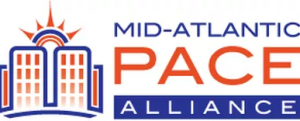 The much anticipated MAPA Regional Toolkit has been released!
The much anticipated MAPA Regional Toolkit has been released!
The Mid-Atlantic PACE Alliance, or MAPA, is comprised of state agencies, non-profit institutions, and private businesses working to accelerate the development and utilization of C-PACE in Virginia, Maryland, and DC. As part of their objective to accelerate the development and utilization of C-PACE programs within the tri-state area, MAPA developed a regional toolkit with feedback and input from C-PACE experts across the country.
The toolkit is a resource for stakeholders, including but not limited to local governments, program administrators, building owners, contractors, capital providers, and local lenders, providing best practices specific to this region. For localities, the provided guidance and resources streamline efforts to develop and launch a C-PACE program.
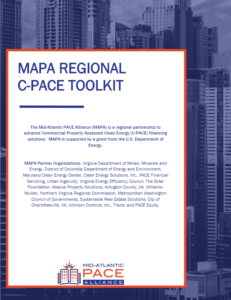
“[The toolkit] includes guidance on program development, financial underwriting, technical project criteria, sample program documents, and a model ordinance developed by the Virginia Energy Efficiency Council (VAEEC). This section also includes information on Arlington County’s C-PACE program, the first active C-PACE program in Virginia which launched in January 2018.”
With C-PACE still relatively new in Virginia, there is still a need for materials that will help stakeholders better understand the benefits of the program. Therefore, along with program guidance for interested localities, the toolkit also includes marketing information and resources. These materials help educate stakeholders in an effort to build support for and to promote C-PACE.
As many of you know, the VAEEC has been carrying out outreach and education to Virginia localities for just shy of two years now. We have encountered countless city and county staff and representatives who have been anticipating the release of this toolkit. With a section completely devoted to setting up a program in Virginia, we believe this toolkit will prove itself to be a vital resource to getting additional C-PACE programs up and running throughout the Commonwealth. We welcome the opportunity to meet with any stakeholder interested in C-PACE.
Contact Jessica Greene (jessica@vaeec.org) if you have any questions, or if you would like to schedule a meeting or call.
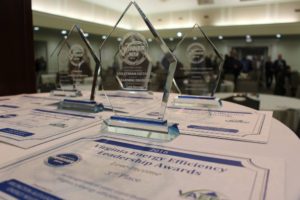
2016 VEEL Awards
Summer has begun, which means we’re gearing up for our annual Virginia Energy Efficiency Leadership (VEEL) Awards. Held in conjunction with the VAEEC Fall 2018 Meeting, the VEEL Awards Ceremony will be held on Wednesday, November 14th at the University of Richmond’s Jepson Alumni Center.
For the third year running, the awards highlight how energy efficiency champions across the Commonwealth are helping businesses, government, schools, and residents save money on energy bills while reducing energy consumption – all while stimulating Virginia’s job growth and economy. Projects or programs can be nominated for the following categories: Academic, Commercial, Government (local or state), Low-Income, and Residential. First, second, and third place will be awarded for each category.
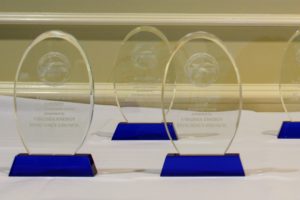
2017 VEEL First Place Awards
The free online awards application process opens on Monday, July 9th and goes through Wednesday, October 3rd. Nominate an acquaintance, a colleague, a role model, or yourself! The only criteria are that the project or program is based in Virginia and is reducing energy consumption. Extra points are given for innovation and creativity, the degree of difficulty in overcoming challenges, and scope of work. Click here to view the Application Scorecard.
Still have questions? We have put together a Q+A guide to help you through the process. For a recap of our 2017 VEEL Awards, check out this blog post.
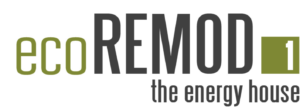 ecoRemod: The Energy House at 608 Ridge Street is home to LEAP’s main office. Located in a historic neighborhood and owned by the City of Charlottesville, the neglected 1920s home was transformed into an innovative energy demonstration house in 2010 through funding by the City of Charlottesville, the University of Virginia, and generous sponsors.
ecoRemod: The Energy House at 608 Ridge Street is home to LEAP’s main office. Located in a historic neighborhood and owned by the City of Charlottesville, the neglected 1920s home was transformed into an innovative energy demonstration house in 2010 through funding by the City of Charlottesville, the University of Virginia, and generous sponsors.
Inspired by LEAP’s mission to facilitate energy efficiency and renewables for Charlottesville residents, this project allowed the City to take the lead in showing how residential energy efficiency can be achieved by preserving a historic home and attaining close to zero net energy use.
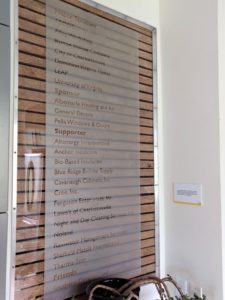
Truth window displaying the original laths and project sponsors
Lesley Fore, Executive Director of LEAP, said “LEAP has been so fortunate to work in a space that we can also use as a way to demonstrate the energy efficiency and renewable technology improvements that we recommend every day to home and business owners. ecoREMOD is a wonderful gathering place for school and community groups who want to learn more about what we do and how we do it. The truth windows and signage throughout the house really allow for a better understanding of energy efficiency, which is usually hidden behind walls.”
As a bonus, working in a 1920s house fits just with our organizational culture. We enjoy the homey-ness, the natural light, and the spaciousness. It’s a great work environment.” – Lesley Fore
This effort to show and create residential energy efficiency has not gone unnoticed. In 2013, the ecoRemod was awarded the US Green Building Council’s Leadership Energy and Environmental Design (LEED) Platinum certification, the highest rating possible, for achievement in green homebuilding and design.
See for yourself how energy and water improvements can be achieved in your home & visit the ecoRemond today! Email LEAP at info@leap-va.org or call at 434-227-4666 to set up an appointment or to schedule a tour for your school, neighborhood, office, or civic group.
VAEEC is honored to have both LEAP and the City of Charlottesville as longtime, active members. We look forward to continuing to work with them to advance energy efficiency across the Commonwealth.
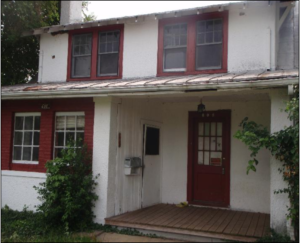
Before remodel
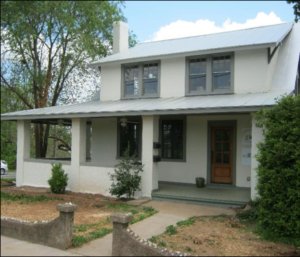
After remodel
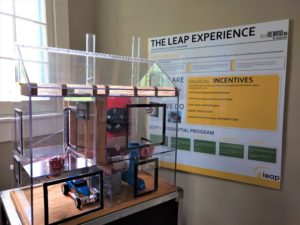
Airtightness display
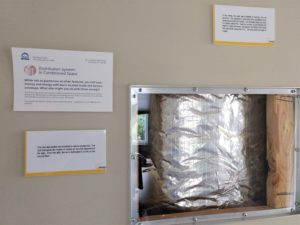
Duct insulation to reduce energy loss
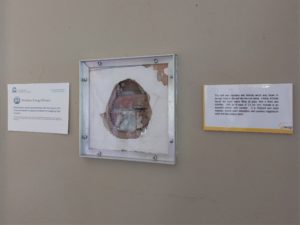
Airkrete exterior wall insulation
As mentioned at our Spring 2018 Meeting, the final Uniform Statewide Building Code (USBC) was published in the Virginia Register on April 30th. There is currently a 30-day public comment period open for any citizen who has concerns regarding these regulations.
If you have been following this process, then you will recall that VAEEC, in concert with our members and partners, was successfully able to work with home builders and code officials to include more energy efficiency measures in this new USBC update.
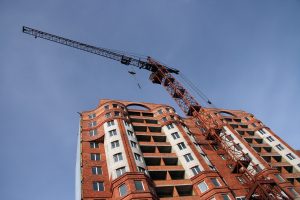
Initially, we anticipated the final regulations back in December with an effective date of July 1, 2018. Unfortunately, there was a major delay, which has now pushed the effective date to September 4th for the USBC and October 16th for the Fire Prevention Code. Earlier this week, we learned that this will most likely cause a delay for the next cycle update. It does not look like there is an appetite to start the next update cycle in 2019, as originally planned.
We will keep you posted as we learn more.
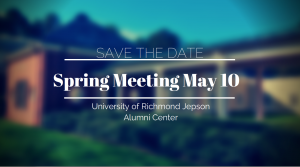
May is quickly approaching and we cannot wait to see all of you at our Annual Spring Meeting in just a few short weeks!
The meeting will be held at the University of Richmond in the Jepson Alumni Center on May 10th from 10:30 to 2:30. Arrive at 10:00 am to get in some extra networking before the meeting begins. Once you get settled in, help make VAEEC the best that it can be by participating in our 2018 Board Elections and, for the first time, a live membership poll that will be conducted via text message! The poll will consist of no more than five questions with multiple choice and write-in answers. Let VAEEC know how we can better serve you!
Our breakout sessions this year will focus on Commercial Building Automation and Residential Utility Programs. The commercial panel will offer participants a chance to interact with panelists to learn more about commercial building automation and to overcome existing challenges with their building automation systems.
Staff from Dominion Energy and Appalachian Power Company will be on the utility panel to discuss how they plan to turn their commitments to energy efficiency- in the new utility spending bill that the Governor signed into law last month- into reality. Join either group to brainstorm how energy efficiency can grow even further in Virginia.
During lunch, we will be joined by the Secretary or Deputy Secretary of Natural Resources to lay out the Governor’s vision and priorities for energy efficiency over the next four years. This will be a great opportunity for us to connect with the new administration on our work.
Our final panel of the day will be a fun, interactive session that provides you with the opportunity to shape VAEEC’s work for the remainder of the year. After a brief overview, attendees will join one of four breakout groups to discuss a variety of issues: Residential programs, Local Government activities, Utility Program expansion or Commercial PACE. We can’t wait to see what you all come up with.
One of the many benefits of being a member of VAEEC is having your chance to shine! Share your success story during the Member Share portion of our event. Email Jenn Fisher, our new Administrative Assistant, at info@vaeec.org to sign up in advance. New this year, we are also providing our members with the opportunity to leave out their business cards and marketing materials on our Member Networking table. In order to accommodate all materials, we are asking our members to email your information to info@vaeec.org by May 7th at 5pm.
 If you are not yet a member but want to take advantage of this and the other great benefits that come with a VAEEC membership, the week of the Spring Meeting is the best week to join! Join at any membership level above Individual between May 7th and May 10th, and your name will be entered to win a $25 Amazon gift card!
If you are not yet a member but want to take advantage of this and the other great benefits that come with a VAEEC membership, the week of the Spring Meeting is the best week to join! Join at any membership level above Individual between May 7th and May 10th, and your name will be entered to win a $25 Amazon gift card!
Hurry up and register today! Registration closes next Monday, April 30th. For members, media, or speakers please use this link to register. If you are not yet a member of VAEEC, please register here. We look forward to seeing you on May 10th!
Happy (Almost) Earth Day Everyone!
Since 1970, April 22 has become a globally recognized day of action and education. Earth Day events are coordinated in over 192 countries and bring people together to celebrate the amazing world around us and recognize the worth in protecting it. Our planet is remarkable and there’s much we can learn from it. In fact, there’s a scientific discipline dedicated to studying and copying nature–biomimicry.

Biomimicry aims to learn from nature to engineer the future. The discipline looks to solve problems faced by humans by observing how organisms and natural systems deal with the very same issues. Reducing energy use is one problem scientists and engineers are tackling by looking at the world around them to inspire solutions.
Here are four examples of energy efficiency through biomimicry:
In the U.S. alone in 2016, 40% of total energy consumption came from the commercial and residential sectors, primarily from buildings. Buildings suck energy in their heating and cooling systems. Even energy efficient buildings with blinds and shades designed to conserve energy use plug-in electricity and batteries. Cones produced from trees like pines, spruce, hemlock, and fir respond naturally to humidity and moisture to open, using minimal energy in the process. Cordt Zollfrank, a chemist, forest scientist and materials researcher at the Technical University of Munich (TUM), is working to design buildings that would respond similarly. The concept could be used wherever buildings experience humidity changes, such as in climate control units.
Humpback whales are the largest animal on the planet, yet they maneuver through the water fast enough to chase fish. Not only are humpbacks quick enough to chase down a meal, but they have to make tight turns as well. Humpbacks are able to make tight maneuvers by putting their flippers at sharp angles of attack. Angle of attack in fluid dynamics is the angle between a reference line representing a body moving and the vector line representing the motion between the body and the fluid through which it is moving. Angles of attack and lift are closely linked, so raising the angle of attack increases lift as well. This movement is helped by tubercles, which create scalloped edges on the leading side of their flippers. This gives them more lift to turn. Professor Frank Fish at West Chester University studied tubercles and the scallop shape and found that tubercles increased the angle of attack up to 42 percent. Engineers have begun to add tubercles and scalloped blades on wind turbines, creating a higher angle, enabling more lift and increasing efficiency.
Equipment in buildings usually function independently and in isolation of one another. They are set on a single thermostat or timer that doesn’t have the capability of knowing what else is currently operating in the building. Since equipment doesn’t communicate with one another they often run at the same time, wasting energy. The clean technology company Encycle created Swarm Logic which can cut a property owner’s electric costs 5-10% or more a year. The technology is based on the way bees and other social insects communicate and coordinate with one another. The controllers establish a wireless network among power-consuming appliances and this enables them to communicate among themselves autonomously. Once the communication network is set then an algorithm is created so the connected appliances spread out their energy demand.
Boeing and NASA have teamed up to find ways for major airlines to save jet fuel. The answer they came up with? Copy geese. By lining up cruising airplanes in a V-formation like migrating geese, the planes leap in efficiency without investing in new technology or changing the designs of individual planes. The concept is called wake surfing. It involves harvesting energy from a lead plane by cutting down on the drag and wind resistance from the planes (or birds) following the leader. The method is still in the works but has the potential to cut down fuel bills and make air travel more energy efficient.
Nature has already solved many of the problems we face today. Animals, plants, microbes, and systems have undergone billions of years or trial and error. These biomimicry breakthroughs in energy efficiency are just a few of the ways emulating nature is shaping the future of sustainable innovation.

 The event proved successful as approximately 30 green business and energy efficiency professionals showed up to meet, mingle, learn about energy efficiency, and soak up the sun on Postbellum‘s rooftop deck.
The event proved successful as approximately 30 green business and energy efficiency professionals showed up to meet, mingle, learn about energy efficiency, and soak up the sun on Postbellum‘s rooftop deck. For our members outside of the Richmond-area, we want to include you too. Let us know if you would like to partner to co-host a happy hour event in your area by emailing info@vaeec.org.
For our members outside of the Richmond-area, we want to include you too. Let us know if you would like to partner to co-host a happy hour event in your area by emailing info@vaeec.org.
 There has been an increase in C-PACE activity and progress across the Commonwealth in the past few months, including several localities taking steps to enact their own program. Learn about these updates and resources by reading below, or by listening to a recording of our September webinar,
There has been an increase in C-PACE activity and progress across the Commonwealth in the past few months, including several localities taking steps to enact their own program. Learn about these updates and resources by reading below, or by listening to a recording of our September webinar,  When looking to significantly reduce energy costs of a state facility, a state agency can enter into an energy performance-based contract with an energy performance contractor. This Energy Performance Contract, or EPC, is an agreement between a contractor or energy services company (ESCO) and a customer to meet a guaranteed level of energy savings as a condition of payment.
When looking to significantly reduce energy costs of a state facility, a state agency can enter into an energy performance-based contract with an energy performance contractor. This Energy Performance Contract, or EPC, is an agreement between a contractor or energy services company (ESCO) and a customer to meet a guaranteed level of energy savings as a condition of payment.  By October 1st, the State Energy Office of the Department of Mines, Minerals and Energy (DMME) must prepare an Energy Plan that covers a 10 year period and submit that plan to the Governor, the SCC Commissioners and the General Assembly. This Energy Plan is required to propose actions that are consistent with the Commonwealth’s Energy Objectives (VA. Code 67-201) including projections of energy consumption, analysis of efficient use of energy resources and conservation initiatives, analysis of whether there is a disproportionate adverse impact on economically disadvantaged or minority communities, and recommendations for legislative, regulatory, and other public and private actions.
By October 1st, the State Energy Office of the Department of Mines, Minerals and Energy (DMME) must prepare an Energy Plan that covers a 10 year period and submit that plan to the Governor, the SCC Commissioners and the General Assembly. This Energy Plan is required to propose actions that are consistent with the Commonwealth’s Energy Objectives (VA. Code 67-201) including projections of energy consumption, analysis of efficient use of energy resources and conservation initiatives, analysis of whether there is a disproportionate adverse impact on economically disadvantaged or minority communities, and recommendations for legislative, regulatory, and other public and private actions. 












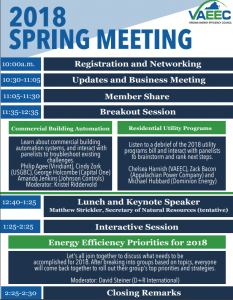
 If you are not yet a member but want to take advantage of this and the other great benefits that come with a VAEEC membership, the week of the Spring Meeting is the best week to join! Join at any membership level above Individual between May 7th and May 10th, and your name will be entered to win a $25 Amazon gift card!
If you are not yet a member but want to take advantage of this and the other great benefits that come with a VAEEC membership, the week of the Spring Meeting is the best week to join! Join at any membership level above Individual between May 7th and May 10th, and your name will be entered to win a $25 Amazon gift card! 